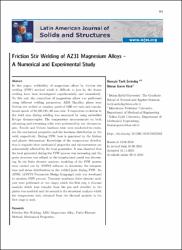| dc.contributor.author | Serindağ, Hüseyin Tarık | |
| dc.contributor.author | Gören-Kıral, Binnur | |
| dc.date.accessioned | 12.07.201910:50:10 | |
| dc.date.accessioned | 2019-07-12T22:07:00Z | |
| dc.date.available | 12.07.201910:50:10 | |
| dc.date.available | 2019-07-12T22:07:00Z | |
| dc.date.issued | 2017 | |
| dc.identifier.citation | Serindag, H. T., Goren-Kiral, B. (2017). Friction stir welding of AZ31 magnesium alloys – A numerical and experimental study. Latin American Journal of Solids and Structures,
14(1), 113-130. doi: 10.1590/1679-78253162 | en_US |
| dc.identifier.issn | 1679-7825 | |
| dc.identifier.uri | https://doi.org/10.1590/1679-78253162 | |
| dc.identifier.uri | https://hdl.handle.net/20.500.12508/823 | |
| dc.description | WOS: 000394522300007 | en_US |
| dc.description | Science Citation Index Expanded | en_US |
| dc.description.abstract | In this paper, weldability of magnesium alloys by friction stir welding (FSW) method which is difficult to join by the fusion welding have been investigated experimentally and numerically. To this end, the connection of magnesium alloys was performed using different welding parameters. AZ31 Mg-alloy plates were friction stir welded at rotation speed of 1200 rev/min and translational speeds of 80,100,120,140 mm/min. Temperature evolution in the weld zone during welding was measured by using embedded K-type thermocouples. The temperature measurements on both advancing and retreading sides were performed by ten thermocouples. Tensile and Vickers hardness tests were conducted to evaluate the mechanical properties and the hardness distribution on the weld, respectively. During FSW, heat is generated by the friction and plastic deformation. Knowledge of the temperature distribution is requisite since mechanical properties and microstructure are substantially affected by the heat generation. It was observed that the heat generated during the FSW process was increasing and the grain structure was refined as the translational speed was decreasing. In the finite element analyses, modeling of the FSW process were carried out by ANSYS software to determine the temperature and stress distributions in the welded joint during FSW. An APDL (ANSYS Parametric Design Language) code was developed to simulate FSW process. Transient nonlinear finite element analyses were performed at two stages which the first step is thermal analysis which heat transfer from the pin and shoulder to the plates was modeled and the second is the structural analysis which the temperature data obtained from the thermal analysis in the first stage is used. | en_US |
| dc.language.iso | eng | en_US |
| dc.publisher | Brazilian Association of Computational Mechanics | en_US |
| dc.relation.isversionof | 10.1590/1679-78253162 | en_US |
| dc.rights | info:eu-repo/semantics/openAccess | en_US |
| dc.subject | Friction Stir Welding | en_US |
| dc.subject | AZ31 Magnesium Alloy | en_US |
| dc.subject | Finite Element Method | en_US |
| dc.subject | Mechanical Properties | en_US |
| dc.subject.classification | Friction stir welding | Research laboratories | Tool pin | en_US |
| dc.subject.classification | Engineering, Civil | Engineering, Mechanical | Mechanics | en_US |
| dc.subject.other | finite element method | en_US |
| dc.subject.other | friction | en_US |
| dc.subject.other | heat transfer | en_US |
| dc.subject.other | magnesium alloys | en_US |
| dc.subject.other | mechanical properties | en_US |
| dc.subject.other | plates (structural components) | en_US |
| dc.subject.other | research laboratories | en_US |
| dc.subject.other | temperature measurement | en_US |
| dc.subject.other | thermoanalysis | en_US |
| dc.subject.other | thermocouples | en_US |
| dc.subject.other | tribology | en_US |
| dc.subject.other | vickers hardness | en_US |
| dc.subject.other | vickers hardness testing | en_US |
| dc.subject.other | welds | en_US |
| dc.subject.other | ANSYS parametric design language | en_US |
| dc.subject.other | AZ31 magnesium alloy | en_US |
| dc.subject.other | friction stir welding(FSW) | en_US |
| dc.subject.other | hardness distribution | en_US |
| dc.subject.other | non-linear finite-element analysis | en_US |
| dc.subject.other | numerical and experimental study | en_US |
| dc.subject.other | properties and microstructures | en_US |
| dc.subject.other | temperature evolution | en_US |
| dc.subject.other | friction stir welding | en_US |
| dc.subject.other | engineering | en_US |
| dc.subject.other | mechanical-properties | en_US |
| dc.subject.other | grain-size | en_US |
| dc.subject.other | model | en_US |
| dc.subject.other | microstructures | en_US |
| dc.subject.other | joints | en_US |
| dc.subject.other | speed | en_US |
| dc.title | Friction stir welding of AZ31 magnesium alloys – A numerical and experimental study | en_US |
| dc.type | article | en_US |
| dc.relation.journal | Latin American Journal of Solids and Structures | en_US |
| dc.contributor.department | Mühendislik ve Doğa Bilimleri Fakültesi | en_US |
| dc.contributor.authorID | 0000-0001-7760-9306 | en_US |
| dc.identifier.volume | 14 | en_US |
| dc.identifier.issue | 1 | en_US |
| dc.identifier.startpage | 113 | en_US |
| dc.identifier.endpage | 130 | en_US |
| dc.relation.publicationcategory | Makale - Uluslararası Hakemli Dergi - Kurum Öğretim Elemanı | en_US |
| dc.contributor.isteauthor | Serindağ, Hüseyin Tarık | |
| dc.relation.index | Web of Science (ESCI) - Scopus | en_US |
















